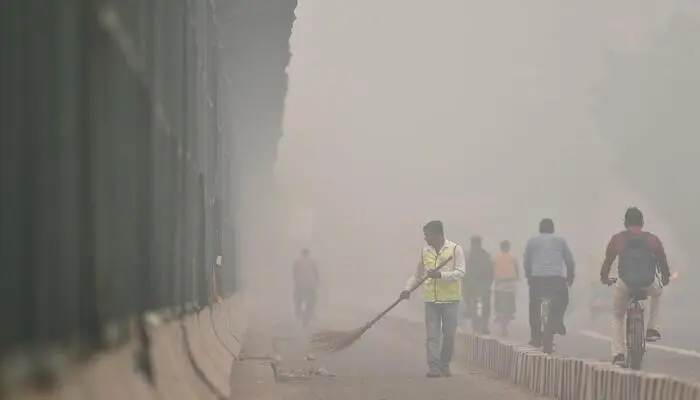
In New Delhi, air pollution has soared to hazardous levels this November, choking the city with toxic smog and highlighting the ongoing air quality crisis in India. Despite emergency measures and proposals for artificial rain, solutions remain elusive, leaving residents grappling with severe health risks.
Record High Pollution Levels
Delhi’s Air Quality Index (AQI) hit a peak of 493 this month, far exceeding the World Health Organization’s (WHO) recommended limit of 15 micrograms of PM2.5 per cubic meter. This figure is more than 30 times higher than safe levels. As winter approaches, colder temperatures trap pollutants close to the ground, worsening the smog. The city, home to 33 million people, consistently ranks among the most polluted in the world.
Government Response and Emergency Measures
Authorities have implemented drastic steps to mitigate pollution. Schools were shut, and businesses were ordered to operate at half capacity. Nonessential construction work and truck movement were also banned. Water tankers now patrol the city, spraying water to settle dust, and mechanical sweepers have been deployed. However, experts doubt the effectiveness of these temporary measures in addressing the root causes of pollution.
The Role of Crop Burning and Winter Factors
Delhi’s toxic air stems from a combination of coal burning, vehicle emissions, and construction dust. The problem escalates in winter when crop stubble burning in neighboring states like Punjab and Haryana generates massive plumes of smoke. These emissions mix with local pollution, creating the infamous smog. Additionally, the festive season in late October often includes firecracker use, compounding the crisis.
The Controversy Over Artificial Rain
Delhi’s government has proposed cloud seeding to create artificial rain, which could clear the smog. This involves dispersing chemicals, such as silver iodide, into clouds to induce precipitation. However, federal authorities have delayed approval, leading to a political standoff between the city’s Aam Aadmi Party (AAP) and the ruling Bharatiya Janata Party (BJP).
Scientists remain skeptical of the plan, pointing out that cloud seeding is experimental and weather-dependent. Sachin Ghude, an air quality expert, argues that it fails to address pollution’s root causes and practical challenges, such as finding suitable weather conditions for the process.
Read: Brazil and Uruguay Clash in 12th Round of World Cup Qualifiers
National Initiatives and Their Limitations
India has introduced several initiatives to tackle air pollution. The Bharat Stage Emission Standards (BSES), launched in 2000, aims to regulate vehicle emissions. The National Clean Air Programme (NCAP), started in 2019, seeks to reduce particulate matter by 20–30% by 2026. However, critics argue these programs focus too narrowly on individual cities, neglecting the regional coordination necessary for significant improvement.
A Persistent Health Crisis
The high concentration of PM2.5 particles in Delhi’s air poses serious health risks, particularly for children, the elderly, and individuals with preexisting conditions. The situation underscores a broader issue: systemic inaction and a lack of long-term planning to combat pollution.
As Delhi continues to grapple with its annual smog crisis, solutions require collaborative efforts, stricter enforcement, and a focus on eliminating root causes rather than temporary fixes.
Follow us on Google News, Instagram, YouTube, Facebook,Whats App, and TikTok for latest updates
